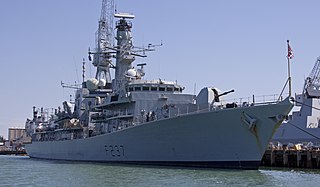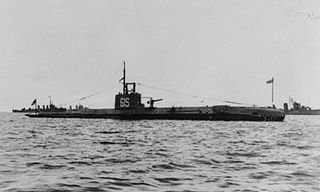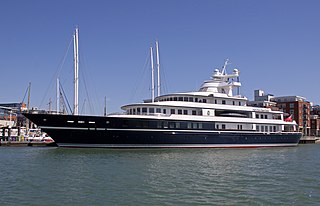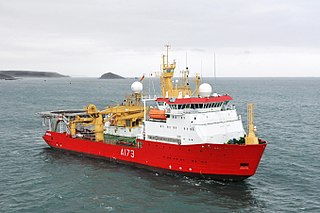
RV Calypso is a former British Royal Navy minesweeper converted into a research vessel for the oceanographic researcher Jacques Cousteau, equipped with a mobile laboratory for underwater field research. She was severely damaged in 1996 and was planned to undergo a complete refurbishment in 2009–2011 that has not been accomplished. The ship is named after the Greek mythological figure Calypso.

The third and current HMS Argyll is a Type 23 Duke-class frigate. She is currently the oldest serving Type 23 frigate in the Royal Navy. Like all of her class she is named after a British dukedom, in this case that of Argyll. HMS Argyll was laid down in March 1987 by Yarrow Shipbuilders at Glasgow, and launched in 1989 by Lady Wendy Levene, sponsored by the Worshipful Company of Paviors. She was commissioned in May 1991. Argyll is currently based at HMNB Devonport.

HMS Triumph is a Trafalgar-class nuclear submarine of the Royal Navy and was the seventh and final boat of her class. She is the nineteenth nuclear-powered hunter-killer submarine built for the Royal Navy. Triumph is the tenth vessel, and the second submarine to bear the name. The first HMS Triumph was a 68-gun galleon built in 1561. As of 2022, she is the last boat of her class remaining in service.

HMS Westminster is a Type 23 frigate of the Royal Navy, and the second ship to bear the name. She was launched on 4 February 1992 and named for the Dukedom of Westminster.

HMS Grafton (H89) was a G-class destroyer built for the Royal Navy during the mid-1930s. During the Spanish Civil War of 1936–1939 the ship spent considerable time in Spanish waters, enforcing the non-intervention measures agreed by Britain and France. After the beginning of World War II she was transferred from the Mediterranean Fleet to Great Britain for escort and contraband inspection duties. Grafton was refitting when the Norwegian Campaign began in April 1940, but the ship escorted convoys to Norway once her refit was completed. She evacuated British troops from the Dunkirk bridgehead in May, but was sunk by a German submarine after she stopped to rescue survivors from another British destroyer.

HMS Ambuscade was a British Royal Navy destroyer which served in the Second World War. She and her Thornycroft competitor, HMS Amazon, were prototypes designed to exploit advances in construction and machinery since World War I and formed the basis of Royal Navy destroyer evolution up to the Tribal of 1936.

HMS Cavalier is a retired C-class destroyer of the Royal Navy. She was laid down by J. Samuel White and Company at East Cowes on 28 March 1943, launched on 7 April 1944, and commissioned on 22 November 1944. She served in World War II and in various commissions in the Far East until she was decommissioned in 1972. After decommissioning she was preserved as a museum ship and currently resides at Chatham Historic Dockyard.

HMS Tyne is a River-class offshore patrol vessel built by Vosper Thornycroft in Southampton for the Royal Navy to serve as a fishery protection unit within the United Kingdom's waters along with her two sister ships Mersey and Severn. All three were commissioned into service in 2003 to replace the five older Island-class patrol vessels.

HNoMY Norge is the Royal Yacht of the King of Norway. One of only three remaining Royal Yachts in Europe, the ship's name Norge is Norwegian Bokmål for Norway. The Royal Yacht Norge was the Norwegian people's gift to King Haakon VII in 1947. The yacht is owned by the King but maintained and crewed by the Royal Norwegian Navy. Originally built in 1937 in the United Kingdom for Thomas Sopwith, she served in the Royal Navy as an armed yacht during the Second World War.

HMS Swordfish (61S) was a first-batch S-class submarine built for the Royal Navy during the 1930s. Commissioned in 1932, she was given the pennant number 61S and was assigned to the 2nd Submarine Flotilla.

Harry John Hyams was a British millionaire who initially made his money as a speculative property developer. He was best known as the developer of the Centre Point office building in London.
Vosper & Company, often referred to simply as Vospers, was a British shipbuilding company based in Portsmouth, England.

HMS Decoy was a D-class destroyer of the Royal Navy. Ordered in 1931, the ship was constructed by John I. Thornycroft & Company, and entered naval service in 1933. Decoy was initially assigned to the Mediterranean Fleet before she was transferred to the China Station in early 1935. She was temporarily deployed in the Red Sea during late 1935 during the Abyssinia Crisis, before returning to her duty station where she remained until mid-1939. Decoy was transferred back to the Mediterranean Fleet just before the Second World War began in September 1939. She briefly was assigned to West Africa for convoy escort duties in 1940 before returning to the Mediterranean. The ship participated in the Battles of Calabria without significant damage and escorted ships of the Mediterranean Fleet for most of the rest of the year.
Sir Bernard Dudley Frank Docker was an English industrialist. Born in Edgbaston, Birmingham, he was the only child of Frank Dudley Docker, an English businessman and financier.

MY Meserret III is a luxury yacht built by Peene-Werft at Wolgast in 1992. It is one of the world's largest yachts. The yacht was formerly known as Leander G. She is owned by Mehmet Omer Koç.

HMS Untamed was a Royal Navy U-class submarine built by Vickers-Armstrongs, High Walker. So far, she has been the only ship of the Royal Navy to bear the name Untamed. On 30 May 1943, she sank during a training exercise in the Firth of Clyde with the loss of all 35 of her crew. Untamed was subsequently salvaged and renamed HMS Vitality, another unique name, and lasted until 1946 when she was scrapped.

HMS Protector is a Royal Navy ice patrol ship built in Norway in mid 2000. As MV Polarbjørn she operated under charter as a polar research icebreaker and a subsea support vessel. In 2011, she was chartered as a temporary replacement for the ice patrol ship HMS Endurance and was purchased by the British Ministry of Defence in early September 2013. As DNV Ice Class 05 the vessel can handle first year ice up to 0.5 metres (20 in).

HMS Evadne was a converted yacht, commissioned as a warship by the Royal Navy during the Second World War. She survives today as the yacht Marala.

HMS Crispin was a C-class destroyer of the Royal Navy built by J. Samuel White, Cowes between 1944 and 1946. She was originally to have been named HMS Craccher. She was sold to the Pakistan Navy in 1958 and renamed PNS Jahangir. She was scrapped in 1982.





















